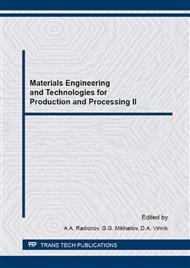[1]
E.Y. Yazici, H. Deveci, Extraction of metals from waste printed circuit boards (WPCBs) in H2SO4–CuSO4–NaCl solutions, Hydrometallurgy. 139 (2013) 30-38.
DOI: 10.1016/j.hydromet.2013.06.018
Google Scholar
[2]
Y. Chu, M. Chen, Sh. Chen, B. Wang, K. Fu, H. Chen, Micro-copper powders recovered from waste printed circuit boards by electrolysis, Hydrometallurgy. 156 (2015)152-157.
DOI: 10.1016/j.hydromet.2015.06.006
Google Scholar
[3]
H. Wei, D. Xue-chen, Z. Lei, Characterization of ultrafine copper powder prepared by novel electrodeposition method, J. Cent. S. Univ. Technol. 16 (2009) 708-712.
DOI: 10.1007/s11771-009-0117-0
Google Scholar
[4]
R. Kh. Nekouei, F. Rashchi, Ar. Ravanbakhsh, Copper nanopowder synthesis by electrolysis method in nitrate and sulfate solutions, Powder Technology. 250 (2013) 91-96.
DOI: 10.1016/j.powtec.2013.10.012
Google Scholar
[5]
I. Haas, S. Shanmugam, A. Gedanken, Pulsed sonoelectrochemical synthesis of size-controlled copper nanoparticles stabilized by poly (N-vinylpyrrolidone), J. Phys. Chem. B. 110 (2006) 16947-16952.
DOI: 10.1021/jp064216k
Google Scholar
[6]
M.G. Pavlović, J.L. Pavlović, I.D. Doroslovački, N.D. Nikolić, The effect of benzoic acid on the corrosion and stabilisation of electrodeposited copper powder, Hydrometallurgy. 73 (2004) 155-162.
DOI: 10.1016/j.hydromet.2003.08.005
Google Scholar
[7]
M.S. Lipkin, V.M. Lipkin, A.A. Naumenko, A.S. Misharev, F.R. Tulaeva, E.A. Rybalko, N.A. Lytkin, V.G. Shishka, A.N. Bogdanchenko, Synthesis of Metal Nano-Powders in Nonstationary Electrolysis, in: Proceeding of ECS Meeting Abstracts Cancun Mexico: Emerging nanomaterials and devices. (2014).
DOI: 10.1149/ma2014-02/38/1891
Google Scholar
[8]
G. Orhan, G. Hapci, Effect of electrolysis parameters on the morphologies of copper powder obtained in a rotating cylinder electrode cell, Powder Technol. 201 (2010) 57-63.
DOI: 10.1016/j.powtec.2010.03.003
Google Scholar
[9]
D.R. Gabe, G.D. Wilcox, J. Gonzalez-Garcia, F.C. Walsh, The rotating cylinder electrode: its continued development and application, Journal of Applied Electrochemistry. 28 (1998) 759-780.
DOI: 10.1023/a:1003464415930
Google Scholar
[10]
V.M. Lipkin, Y.M. Berezhnoi, M.S. Lipkin, Effect of substrate nature and electrolysis modes on ultramicron and nanosized electrolytic powders formation regularities, Materials Science Forum. 843 (2016) 22-27.
DOI: 10.4028/www.scientific.net/msf.843.22
Google Scholar
[11]
K.I. Popov, S.B. Krstić, M.Č. Obradović, M.G. Pavlović, Lj.J. Pavlović, E.R. Ivanović, The effect of the particle shape and structure on the flowability of electrolytic copper powder, III, A model of the surface of a representative particle of flowing copper powder electrodeposited by reversing current, Journal of the Serbian Chemical Society. 69 (2004).
DOI: 10.4028/www.scientific.net/msf.453-454.393
Google Scholar
[12]
K.I. Popov, S.B. Krstić, M.G. Pavlović, The critical apparent density for the free flow of copper powder, Journal of the Serbian Chemical Society. 68 (2003) 511-513.
Google Scholar
[13]
R.K. Nekouei, F. Rashchi , Ah.A. Amadeh, Using design of experiments in synthesis of ultra-fine copper particles by electrolysis, Powder Technology. 237 (2013) 165-171.
DOI: 10.1016/j.powtec.2013.01.032
Google Scholar
[14]
M. Pavlovic, Lj. Pavlovic, V. Maksimovic, N. Nikolic, K. Popov, Characterization and morphology of copper powder particles as a function of different electrolytic regimes, International Journal of Electrochemistry Science. 5 (2010) 1862-1878.
DOI: 10.1016/s1452-3981(23)15390-9
Google Scholar
[15]
S. Jafar, Effects of new additives (lanolin) on the electro-deposition of copper powder, Engineering and Technology Journal. 27 (2009) 2308-2321.
Google Scholar
[16]
H. Dong, G. Shao, Study of centrifugal high-speed chromium plating, Electroplat Finish. 1 (2004) 31-32. (in Chinese).
Google Scholar
[17]
M. Wang, Z. Wang, Z. Guo, Preparation of electrolytic copper powders with high current efficiency enhanced by super gravity field and its mechanism, Trans. Nonferous Met. Soc. Chine. 20 (2010) 1154-1160.
DOI: 10.1016/s1003-6326(09)60271-5
Google Scholar
[18]
R.K. Nekouie, F. Rashchi, N.N. Joda, Effect of organic additives on synthesis of copper nano powders by pulsing electrolysis, Powder. Technology. 237 (2013) 554-561.
DOI: 10.1016/j.powtec.2012.12.046
Google Scholar
[19]
J. Elplancke, M. Sun, T.J. O'Keefe, R. Winand, Nucleation of electrodeposited copper on anodized titanium, Hydrometallurgy. 23 (1989) 47-66.
DOI: 10.1016/0304-386x(89)90017-0
Google Scholar
[20]
W. Yohannes, S.V. Belenov, V.E. Guterman, L.M. Skibina, V.A. Volotchaev, N.V. Lyanguzov, Effect of ethylene glycol on electrochemical and morphological features of platinum electrodeposits from chloroplatinic acid, Journal of Applied Electrochemistry. 6 (2015).
DOI: 10.1007/s10800-015-0820-5
Google Scholar
[21]
K. Popov, T. Kostic, N. Nikolic, E. Strojilkovic, M. Pavlovic, A new approach to metal electrodeposition at a periodically changing rate part I, The reversing overpotential method, J. Electroanal. Chem. 464 (1999) 245-251.
Google Scholar
[22]
M. Quinet, F. Lallemand, L. Ricq, J.Y. Hihn, P. Delobelle, C. Arnould, Z. Mekhalif, Influence of organic additives on the initial stages of copper electrodeposition on polycrystalline platinum, Electrochimica Acta. 54 (2009) 1529-1536.
DOI: 10.1016/j.electacta.2008.09.052
Google Scholar
[23]
V. Saez, T.J. Mason, Sonoelectrochemical synthesis of nano particles, Molecules. 14 (2009) 4284-4299.
Google Scholar
[24]
A.S. Kuzharov, M.S. Lipkin, A.A. Kuzharov, V.M. Lipkin, K. Nguen, V.G. Shishka, E.A. Rybalko, N.A. Lytkin, A.S. Misharev, F.R. Tulaeva, A.I. Gaidar, Green tribology: Disposal and recycling of waste Ni–Cd batteries to produce functional tribological materials, Journal of Friction and Wear. 36 (2015).
DOI: 10.3103/s1068366615040078
Google Scholar
[25]
L.G. Shapiro, Computer and Robot Vision, Volume I, Addison-Wesley, 1992, pp.28-48.
Google Scholar
[26]
A.V. Sedov, M.S. Lipkin, S.M. Lipkin, D.A. Onyshko, N.A. Lytkin, N.V. Rarova, Nondestructive carbon content express-control in steels and alloys, in: Proceeding of International Conference on Physical Mesomechanics of Multilevel Systems 2014. 1623 (2014).
DOI: 10.1063/1.4901498
Google Scholar
[27]
Y.Y. Gerasimenko, S.V. Kucherenko, S.M. Lipkin, M.S. Lipkin, Potential step study of intercalation processes, in: Proceeding of ECS Transactions. 14 (2013) 89-94.
DOI: 10.1149/05814.0089ecst
Google Scholar


